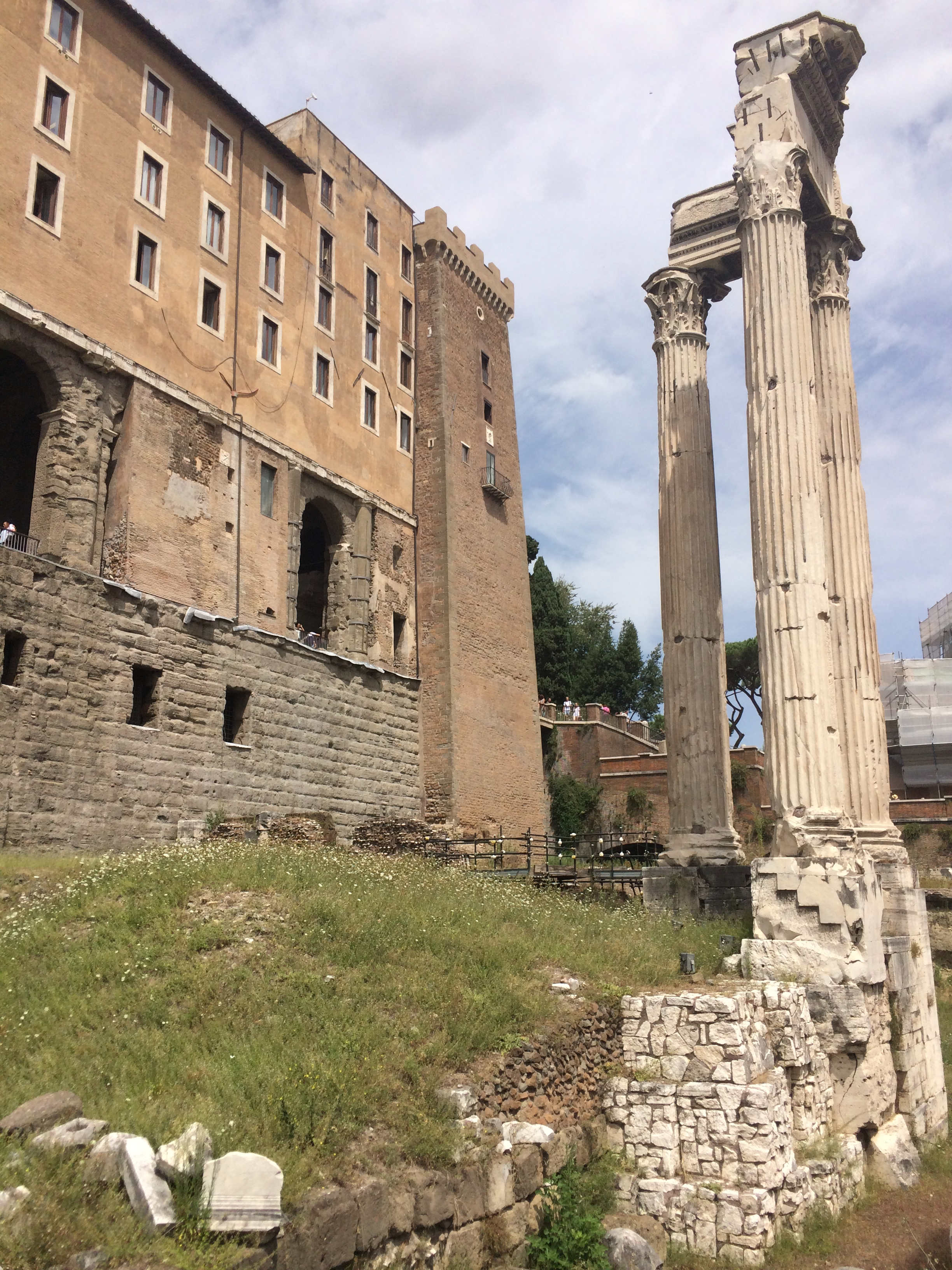|
Tabularium
The Tabularium was the official records office of ancient Rome and housed the offices of many city officials. Situated within the Roman Forum, it was on the front slope of the Capitoline Hill, below the Temple of Jupiter Optimus Maximus, to the southeast of the Arx. Within the building were the remains of the temple of Veiovis. In front of it were the Temples of Vespasian and Concord, as well as the Rostra and the rest of the forum. Presently the Tabularium is only accessible from within the Capitoline Museum, although it still provides a panoramic view over the Forum. The construction of the Tabularium was ordered around 78 BC by the dictator Lucius Cornelius Sulla. The building was completed by Quintus Lutatius Catulus, consul in 78 BC. This was part of a public works programme for the redevelopment of the Capitoline Hill, which had been damaged by a fire in 83 BC. The construction by Catulus is not mentioned in the ancient literature. It is known through an inscription (CIL ... [...More Info...] [...Related Items...] OR: [Wikipedia] [Google] [Baidu] |
Capitoline Hill
The Capitolium or Capitoline Hill ( ; it, Campidoglio ; la, Mons Capitolinus ), between the Forum and the Campus Martius, is one of the Seven Hills of Rome. The hill was earlier known as ''Mons Saturnius'', dedicated to the god Saturn. The word ''Capitolium'' first meant the temple of Jupiter Optimus Maximus later built here, and afterwards it was used for the whole hill (and even other temples of Jupiter on other hills), thus ''Mons Capitolinus'' (the adjective noun of ''Capitolium''). In an etymological myth, ancient sources connect the name to ''caput'' ("head", "summit") and the tale was that, when laying the foundations for the temple, the head of a man was found, some sources even saying it was the head of some ''Tolus'' or ''Olus''. The ''Capitolium'' was regarded by the Romans as indestructible, and was adopted as a symbol of eternity. By the 16th century, ''Capitolinus'' had become ''Capitolino'' in Italian, and ''Capitolium'' ''Campidoglio''. The Capitoline Hill ... [...More Info...] [...Related Items...] OR: [Wikipedia] [Google] [Baidu] |
Temple Of Veiovis
The Temple of Veiovis in ancient Rome was the temple of the god Veiovis. In literature The temple was sited in the saddle of ground "inter duos lucos", between two sacred groves, one on the Arx and one on the Capitolium (the two peaks of the Capitoline Hill). The statue of the god stood next to a statue of a goat. In the same area was also situated the Asylum, where, legend has it, Romulus extended hospitality to fugitives from other parts of the Latium region, in order to populate the new city which he founded, with political refugees, escaped slaves, Latins and Etruscans, and, as Florus has it, Phrygians and Arcadians. Florus, I.9, noted by Emma Dench, ''Romulus' asylum: Roman identities from the age of Alexander to the age of Hadrian'' (Oxford University Press) 2005, p. 2 note 4. Its construction was vowed in 200 BC by the praetor Lucius Furius Purpurio in the Battle of Cremona during the war against the Boii, and then dedicated in 192 BC by Quintus Marcius Ralla. In arc ... [...More Info...] [...Related Items...] OR: [Wikipedia] [Google] [Baidu] |
Circus Maximus
The Circus Maximus (Latin for "largest circus"; Italian: ''Circo Massimo'') is an ancient Roman chariot-racing stadium and mass entertainment venue in Rome, Italy. In the valley between the Aventine and Palatine hills, it was the first and largest stadium in ancient Rome and its later Empire. It measured in length and in width and could accommodate over 150,000 spectators. In its fully developed form, it became the model for circuses throughout the Roman Empire. The site is now a public park. Events and uses The Circus was Rome's largest venue for ''ludi'', public games connected to Roman religious festivals. ''Ludi'' were sponsored by leading Romans or the Roman state for the benefit of the Roman people (''populus Romanus'') and gods. Most were held annually or at annual intervals on the Roman calendar. Others might be given to fulfil a religious vow, such as the games in celebration of a triumph. In Roman tradition, the earliest triumphal ''ludi'' at the Circus were ... [...More Info...] [...Related Items...] OR: [Wikipedia] [Google] [Baidu] |
Temple Of Vespasian And Titus
The Temple of Vespasian and Titus ( la, Templum divi Vespasiani,Platner, Samuel B., and Ashby, Thomas. ''A Topographical Dictionary of Ancient Rome''. London: Oxford UP, 1929; p. 556. it, Tempio di Vespasiano) is located in Rome at the western end of the Roman Forum between the Temple of Concordia and the Temple of Saturn. It is dedicated to the deified Vespasian and his son, the deified Titus. It was begun by Titus in 79 after Vespasian's death and Titus's succession. Titus’ brother, Domitian, completed and dedicated the temple to Titus and Vespasian in approximately 87. Importance Throughout Roman history, there was an emphasis on increasing the fame and glory of a family name, often through monuments commemorating the deceased. Therefore, the temple was constructed to honor the Flavian Dynasty, which comprised the emperors Vespasian (69–79), Titus (79–81), and Domitian (81–96). Historians question whether or not Titus and Domitian had a good relationship; howev ... [...More Info...] [...Related Items...] OR: [Wikipedia] [Google] [Baidu] |


.jpg)
